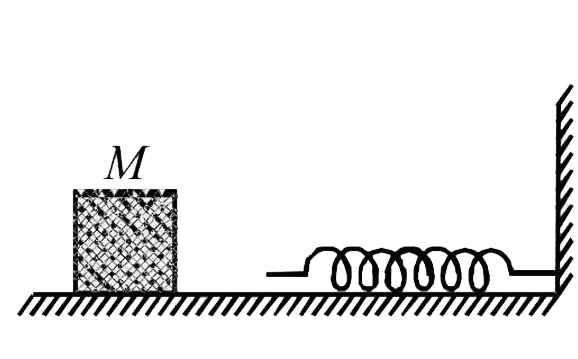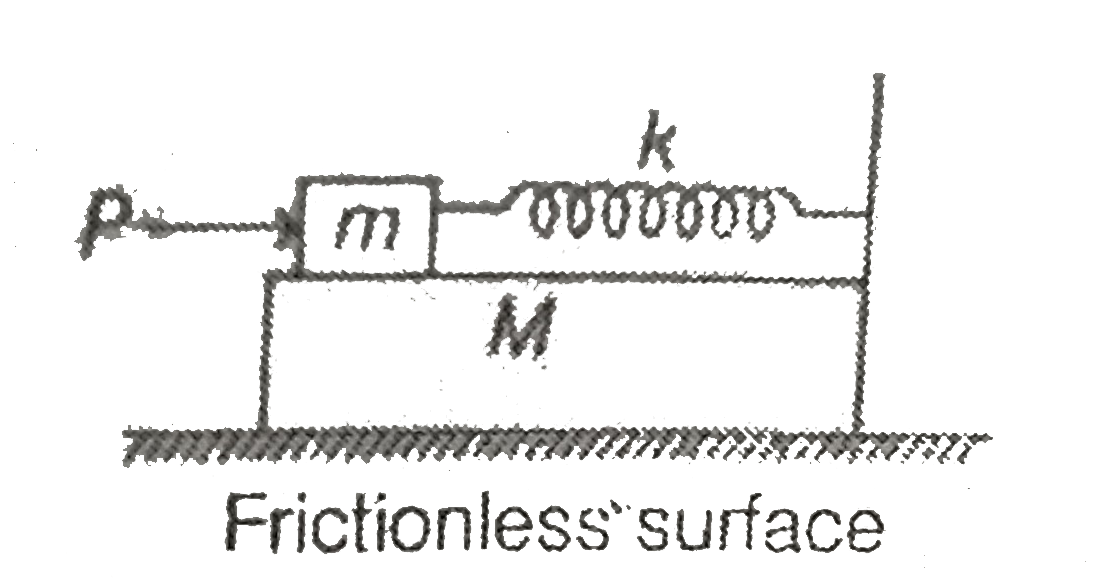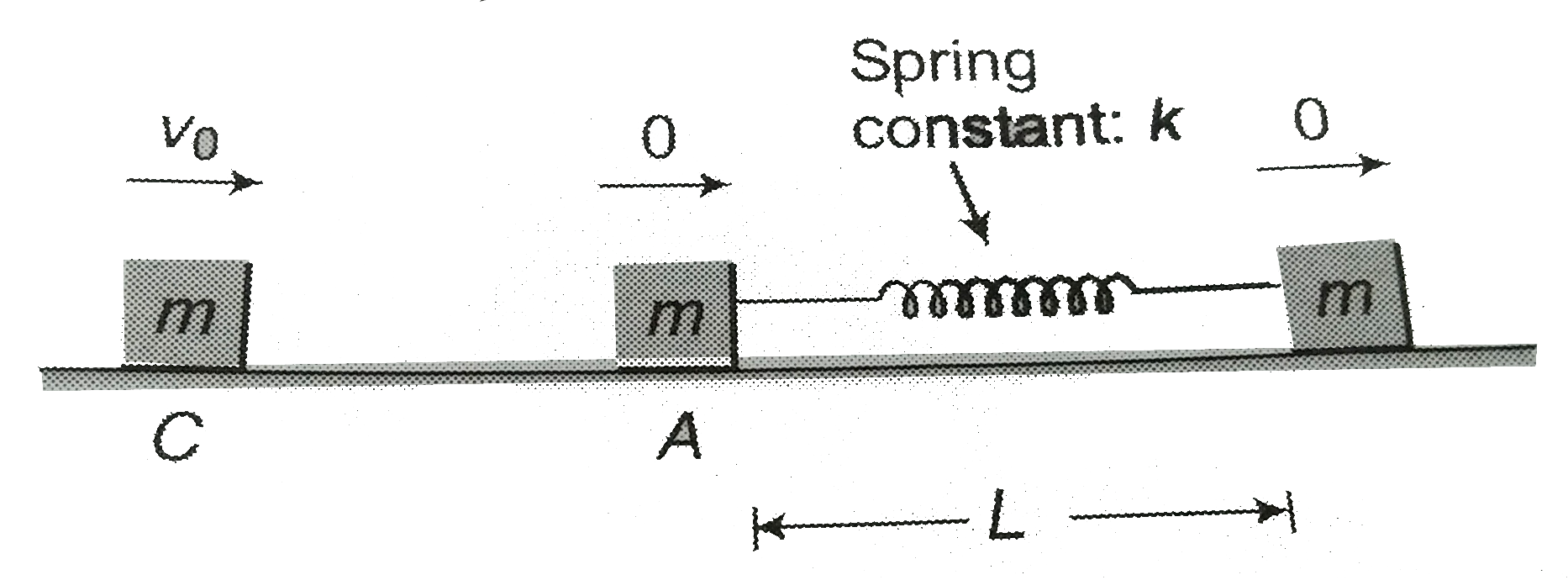The system described in previous question is kept on a frictionless horizontal floor with spring at its natural length. Now a sharp impulse is applied on the block m2 to impart it a speed of v. Calculate velocity acquired by the centre of mass just after the impulse is applied on the block m2. Also calculate maximum possible elongation suffered by the spring.

Velocity of the centre of mass can be written as follows:
vcm=m1v1+m2v2m1+m2=m1×0+m2×vm1×m2=m2vm1×m2
When block my starts moving then it elongates the spring which in turn applies force on blockm, to move it along. Spring force opposes the motion of m, and so its velocity decreases and spring force accelerates the block m, and its velocity increases. Elongation of the spring increases till the time both the blocks acquire common velocity. And this common velocity will be equal to velocity of centre of mass. At this instant elongation of the spring will be maximum.
Let x be the maximum elongation, then using conservation of mechanical energy we can write the following:
Loss in kinetic energy = gain in spring potential energy
12m2v2−12(m1+m2)[m2vm1+m2]2=12kx2
⇒kx2=m2v2−m22v2m1+m2
⇒kx2=m1m22v2m1+m2
⇒x=v√m1m2k(m1+m2)
Topper's Solved these Questions
- BOOK - MODERN PUBLICATIONCHAPTER - SYSTEMS OF PARTICLES AND ROTATIONAL MOTIONEXERCISE - REVISION EXERCISES (Very Short Answer Questions Carrying 1 mark)29videos
SYSTEMS OF PARTICLES AND ROTATIONAL MOTION
- BOOK - MODERN PUBLICATIONCHAPTER - SYSTEMS OF PARTICLES AND ROTATIONAL MOTIONEXERCISE - REVISION EXERCISES (Additional Questions Carrying 1 mark )4videos
SYSTEMS OF PARTICLES AND ROTATIONAL MOTION
- BOOK - MODERN PUBLICATIONCHAPTER - SYSTEMS OF PARTICLES AND ROTATIONAL MOTIONEXERCISE - NCERT FILE (NCERT EXEMPLAR PROBLEMS (SUBJECTIVES QUESTIONS) (Very Short Answer Type Questions))9videos
SYSTEMS OF PARTICLES AND ROTATIONAL MOTION
- BOOK - MODERN PUBLICATIONCHAPTER - PHYSICAL WORLD EXERCISE - Revision exercises (Long answer questions)6videos
PHYSICAL WORLD
- BOOK - MODERN PUBLICATIONCHAPTER - THERMAL PROPERTIES OF MATTEREXERCISE - CHAPTER PRACTICE TEST15videos
THERMAL PROPERTIES OF MATTER
Similar Questions
A rod of mass M and length L is kept on a frictionless horizontal floor. A particle of mass m moving perpendicular to the rod with a speed v strikes at the end of the rod and sticks there. Calculate angular velocity acquired by the combined system.
View SolutionTwo blocks of masses m, and m, are connected to the ends of a spring of spring constant k. System is kept at rest on a frictionless horizontal floor with spring in its natural length. Both the blocks are pulled along opposite directions with forces of same magnitude F. Calculate maximum elongation of spring and distances travelled by the blocks during this motion.
View Solution
Knowledge Check
- Question 1 - Select One
Consider a case of fixed smooth sphere of radius R . A block of mass m is placed at the most poit of the sphere . A sharp impulse is applied on the block to impart it a speed v .
What is the normal reaction between block and the sphere just after the impulse is applied ?Amv2RBmg−mv2RCmgD0 - Question 2 - Select One
Consider a case of fixed smooth sphere of radius R . A block of mass m is placed at the most poit of the sphere . A sharp impulse is applied on the block to impart it a speed v .
What si the maximum possible value of v so that block does not lose contact with the sphere at the top point ?A√5gRB√3gRC√gRD0 - Question 3 - Select One
The block of mass M moving on the frictionless horizontal surface collides with the spring constant k and compresses it by length L . The maximum momention of the block after collision is
 AkL22MB√MkL(c)SCML2kDzero
AkL22MB√MkL(c)SCML2kDzero
Two blocks A and B each of mass m are connected by a massless spring of natural length L and spring constant k. The blocks are initially resting on a smooth horizontal floor with the spring at its natural length. A third identical block C also of mass m moves on the floor with a speed v along the line joining A and B and collides with A. Then
The kinetic energy of the A-B system at maximum compression of the spring is mv2/4
The maximum compression of the spring v√m/3k<br>Thek∈etice≠rgyoftheA−Bsystematmaxiμmcompression<br>Themaxiμmcoppressionofthespr∈gisvsqrt(m//k)View SolutionA block of mass m is attached with a spring of force constant k. The block is kept on a frictionless plank. Mass of the plank is M and it is also kept on a horozontal frictionless surface. Initially the sysetm is stationaryl. An impulse p is applied on the block as shown. The maximum copression in the spring will be
 View Solution
View SolutionTwo blocks A and B of masses m and 2m are connected by a massless spring of natural length L and spring constant k. The blocks are intially resting on a smooth horizontal floor with the spring at its natural length , as shown . A third identical block C of mass m moves on the floor with a speed v0 along the line joining A and B and collides elastically with A. FInd (a) the velocity of c.m. of system (blockA+B+spring) and (b) the minimum compression of spring.
 View Solution
View SolutionBlock of mass m is pushed towards a horizontal spring as shown in figure , with initial speed u .

Spring constant of the spring is K and floor is smooth . Calculate maximum possible compression of the spring .View SolutionInitialy spring in its natural length now a block at mass 0.25 kg is released then find out maximum force by system on floor ?
 View Solution
View Solution

